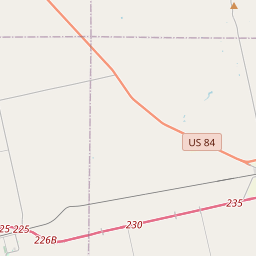Roscoe, Snyder & Pacific Railway
Historical marker location:






The Roscoe, Snyder & Pacific Railway was one of the country’s most successful short-line railroads. Chartered on Oct. 1, 1906, by General F. W. James and a group of Abilene businessmen, it ran from Roscoe to Snyder and Fluvanna, though in 1941 the Fluvanna line was discontinued. Once it was completed, Ed S. Hughes and H.O. Wooten took over the operation. Wooten saved it from a financial crisis by making deals with California produce shippers and with the Santa Fe and Texas & Pacific railroads to use the line as a link between them. In 1967, the company was sold to the Murchison brothers of Dallas and Roger Mize of Snyder. The deregulation of railroads in 1980 resulted in its closing in 1984. Nevertheless, it was a major factor in Roscoe’s settlement and growth. (2012)
As one of the most visible programs of the Texas Historical Commission (THC), historical markers commemorate diverse topics in Texas history, including: the history and architecture of houses, commercial and public buildings, religious congregations, and military sites; events that changed the course of local and state history; and individuals who have made lasting contributions to the state, community organizations, and businesses.
The state of Texas was once an independent country known as the Republic of Texas. It gained independence from Mexico in 1836 and was a separate nation until it was annexed by the United States in 1845.
The first permanent Anglo-American settlers arrived in the 1870s, attracted by the fertile land and opportunities for ranching. The community of Sweetwater was established in 1879, named after the fresh water springs found in the area. The town quickly grew and became an important trading center for the surrounding agricultural and ranching communities.
In the late 19th century, the discovery of oil in nearby areas sparked an economic boom in Nolan County. Oil drilling and production became prevalent, attracting workers and boosting the local economy. This resulted in the development of additional towns and communities, such as Roscoe, that relied on the oil industry for growth and prosperity.
Throughout the 20th century, Nolan County continued to benefit from the oil industry, while also diversifying its economy. The agriculture sector remained important, with cotton farming and cattle ranching being the primary sources of income. Additionally, wind energy became a significant part of the region's economy in recent years, with numerous wind farms being established.
Today, Nolan County is known for its rich history, vibrant communities, and diverse economic activities, including agriculture, oil, and renewable energy. The county's heritage is celebrated through various cultural events and preservation efforts, ensuring that the history of Nolan County remains a significant part of its identity.
Nolan County Timeline
This timeline provides a condensed summary of the historical journey of Nolan County, Texas.
- 1858 - Nolan County is created and organized from Bexar County.
- 1879 - The first permanent settlement is established in the area by brothers Isaac and Lewis Newton from Illinois.
- 1880 - The town of Sweetwater is founded and becomes the first county seat.
- 1881 - Sweetwater wins the election to remain the county seat.
- 1890 - The Texas & Pacific Railway reaches Sweetwater, promoting growth and development in the area.
- 1911 - Roscoe is incorporated and becomes a major agricultural center.
- 1928 - Completion of Lake Sweetwater, providing a reliable water supply for the region.
- 1942-1945 - Nolan County contributes to the World War II effort through the establishment of airbases and military training facilities.
- 1950s - Sweetwater becomes known as the "Windmill City" due to the large number of windmills manufactured in the area.
- 1973 - The Nolan County Coliseum is built, becoming a popular venue for events and activities.
- 2004 - Sweetwater hosts the first annual Rattlesnake Roundup, attracting visitors from around the world.